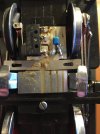Just purchased a used 1981 European style engine that has a small circuit board on the bottom attached to contact slides and closer to back wheels. It has a small switch with a roller that touches one of the back wheels. 

 It looks like it was not original to engine and was added on later in its life. I have my track setup to run mostly starter set engines with 1 amp starter set transformer's. I want to test this engine but do not want to cause damage to it. Can anyone tell me what this board may be, and if I can run it on my track setup. Thanks
It looks like it was not original to engine and was added on later in its life. I have my track setup to run mostly starter set engines with 1 amp starter set transformer's. I want to test this engine but do not want to cause damage to it. Can anyone tell me what this board may be, and if I can run it on my track setup. Thanks


 It looks like it was not original to engine and was added on later in its life. I have my track setup to run mostly starter set engines with 1 amp starter set transformer's. I want to test this engine but do not want to cause damage to it. Can anyone tell me what this board may be, and if I can run it on my track setup. Thanks
It looks like it was not original to engine and was added on later in its life. I have my track setup to run mostly starter set engines with 1 amp starter set transformer's. I want to test this engine but do not want to cause damage to it. Can anyone tell me what this board may be, and if I can run it on my track setup. Thanks